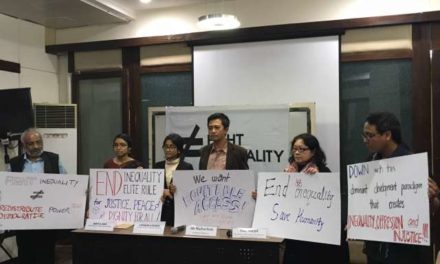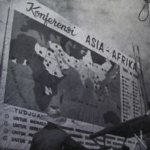THE extent of US military reach is unquestionably vast but exactly how vast is deliberately hazy. According to the US Department of Defense’s 2003 Base Structure Report, a detailed itinerary of US owned military installations, the United States has 702 bases in 40 countries and a further 96 bases in its territories. This figure does not reflect the recent trend of stationing troops on foreign bases where the United States has access rights but not formal ownership of facilities but it does include the large number of US troops stationed for the major military interventions of the 1990s, namely, Bosnia, Saudi Arabia (post Gulf War), and Kosovo. In the wake of September 11, the US invaded Afghanistan and now maintains facilities in Afghanistan, Pakistan, Uzbekistan, Tajikistan and Kyrgyzstan. Since the invasion of Iraq, Gulf States such as Kuwait, Qatar, the United Arab Emirates and Oman are housing US military. The US fear of terrorists hiding out in North Africa has seen the US military web extend to Djibouti on the horn of Africa. And to assist in the other “war” the US administration is fighting – the war on drugs – US reach in Latin America now covers half a dozen countries. This is in addition to the “traditional” US presence in many European countries, Japan and South Korea
In all, the US has a military presence in nearly 60 countries. Even then, this figure doesn’t include the vast network of surveillance installations. Nor does it include the military access agreements or status of forces agreements (SOFAs) the US has signed with nearly 100 countries. These agreements define the legal status of US service personnel serving abroad. Infamously, they typically give the United States jurisdiction over offenses committed by personnel “carrying out official duty”.
The number of installations is also set to grow. According to the Wall Street Journal, bases are also being considered for Azerbaijan, Morocco, Algeria and Tunisia in North Africa and Senegal, Ghana, Mali and Kenya in sub-Saharan Africa. It also mentioned Singapore, Australia, Vietnam, Georgia, Romania, the Philippines and Bulgaria. (1)
“JUST-IN-TIME” WARFARE
The recent shifts in basing strategy were recently described by Foreign Affairs as “the most sweeping changes in the US military posture abroad in half a century.” (2) Many of the major bases the administration has relied upon to police the boundaries of the Cold War, such as Germany, Turkey and South Korea, are being scaled down to make way for a network of “forward operating bases”. These are foreign owned facilities, usually strategically placed airfields or ports to which the US has access rights, with military hardware on stand-by and, although sparsely staffed, can be quickly activated. Defense Department officials envisage these will eventually cover what they have dubbed the “arc of instability” – a vast sweep of the world running from Latin America to North Africa, Central Europe, the Middle East and then to South East Asia. Beyond this would lie a ring of bare-bones “forward
operating locations” or FOLs.
This new basing strategy reflects the administration’s doctrine of preemptive attack against terrorists and hostile states. It is designed to quickly counter a foe who could be anywhere. “We certainly don’t have six months to do it”, commented Maj. Gen. James Jones of US Central Command, “we may only have hours to do it.” (3) A dispersed and flexible fighting force is in contrast to the present US military juggernaut in Germany which maintains approximately 310 military facilities and 95,000 military and civilian personnel. The plan now is to rotate some of the 60,000 troops in Germany between the US and Poland, Bulgaria and Romania.
In another trend of late twentieth century restructuring, it seems that basing personnel will also be victims to the roll back of the welfare state. As a part of a leaner and meaner agenda, these new installations will give up “the paraphernalia of welfare and family support arrangements that have marked overseas basing since
World War 2″. (4)
Where there isn’t a war on “terror”, the US administration is relying on the war on drugs to justify more bases. Citing problems with cocaine production in Colombia and Bolivia, the US has expanded its military presence in Latin America. With the winding down of the US military presence in Panama in 1999, operations were transferred to Puerto Rico and FOLs for the US airforce have been set up in El Salvador, Ecuador, Curacao and Aruba (islands off the coast of Venezuela).
THE SPOILS OF WAR
The spread of US bases reflects the strategic needs and spoils of prior conflict. The establishment of one base during or in the aftermath of one war provides a basis for projecting force in that region and potentially launching the next conflict. Classic examples are the heavy stationing of US troops in Okinawa in Japan and Germany in World War 2 and Saudi Arabia after the first Gulf War. And the pattern continues. Defense department officials plan to keep the Central Asian bases established for the conflict in Afghanistan: Uzbekistan (with its Saddam-esque treatment of dissidents) (5) Tajikistan and Kyrgyzstan are all new US military friends. The US also plans to hold onto four bases in Iraq – although Iraqi resistance thinks otherwise. (6)
WHERE THERE’S OIL, THERE’S BASES
With the revival of US imperialism, comes a new honesty in stating US geo-strategic objectives. The Rand Corporation, an influential conservative US think tank, argued that a major consequence for a US-led war against Iraq will be the US control and boosting of Iraqi oil output, thereby weakening the OPEC quota system and
driving down the global price of oil. “OPEC could plunge into a death spiral”, notes Rand policy analyst James Bartis.(6) Media Magnate Rupert Murdoch agreed, “The greatest thing to come out of this for the world economy…would be $20 a barrel for oil. That’s bigger than any tax cut in any country.”(7) Perhaps it was because of this persuasive argument that all 175 of his newspaper editors were beating the drums of war? (8)
However, with continued resistance in Iraq, the sabotage of pipelines has indefinitely postponed this tax relief. Combined with awkward US-relations with the house of Saud, this has added further impetus to the US Administration’s plan to wean the US economy off Middle Eastern oil. Like flies to a picnic, all the potential alternative points of supply have attracted rumors of US bases being set up. The oil rich Gulf of Guinea in West Africa from which the US imports 1.5m barrels a day is now on Washington’s security radar. The African Oil Policy Initiative Group, a lobbying group comprising oil executives and Pentagon officials reported to congress that the region and its vast oil supplies made it “a ‘vital interest’ in US national security calculations.”(9) It suggested
establishing a US military sub-command for the Gulf of Guinea and setting up bases on the islands of the Republic of Sao Tome and Principe. Unless the US did more to prop up the oil industry there, commented one senior CIA official, “the oil industry ran the risk of imploding as a result of the region’s inherent instability”. (10)
Similarly, there are now two US military aircraft facilities on the Caribbean islands of Aruba and Curacao, a very short bombing run away from the coast of oil-rich, politically troubled and Washington-unfriendly Venezuela. The Caspian region of central Asia, with four percent of the world’s proven oil and gas reserves, will soon to be blessed with three permanent US military bases. US funded military are guarding the Occidental Petroleum Oil facilities in Colombia and in the wake of the war in Afghanistan, the stationing of the US military has now made it possible for US oil company UNOCAL to build a pipeline from Afghanistan to Pakistan. (12)
AN IMPERIAL DESIGN
The new US security strategy is to stop a threat that is potentially ubiquitous – to stop terrorism’s “cancer growing in the middle of nowhere” according to Maj. Gen. Jeffrey B. Kohler. (13) It is no coincidence that this “nowhere” covers most of the Global South. Failed development at the hands of a US-led cabal of corporations and governments has turned 80% percent of the world’s population into forgotten people. And the solution? With
missionary zeal, the Whitehouse’s National Security Strategy seeks to “bring the hope of democracy, development, free markets, and free trade to every corner of the world.” (14) If Iraq is any indication of what this means, the people of the world should start digging bunkers.
Those deviating from the US brand of “globalization” may have to contend with the military muscle of what the Project for a New American Century, the pet think tank of Washington’s back room boys, describes as “America’s grand strategy”. (15) “It is always possible to fall off this bandwagon called globalization” comments US military strategist Thomas Barnett. “And when you do, bloodshed will follow. If you are lucky, so will American troops.” (16) But the US is not some benign global coast guard. With guns blazing in over 200 foreign military interventions, US history suggests that Barnett’s perverse chain of logic is in the wrong order.
* Ben Moxham is a volunteer researcher with Focus on the Global South
(1) The Wall Street journal June 10th 2003
(2) Foreign Affairs, September / October 2003
(3) Washington Post, June 9, 2003
(4) CDI, “Worldwide reorientation of U.S. basing in prospect,
September 19, 2003, www.cdi.org
(5) The Guardian, 26 May 2003. US looks away as new ally
tortures Islamists.
(6) International Herald Tribune, April 21, 2003
(7) Iraqi Oil and the Global Economy, James Bartis,Albany Times-
Union, January 6, 2003
(8) The Bulletin, February 12th, 2003
(9) The Guardian, February 17th, 2003
(10) Guardian Weekly, July 10, 2003
(11) Guardian Weekly, July 10, 2003
(12) New York Times, January 18, 2002
(13) New York Times, July 4, 2003
(14) United States National Security Strategy
(15) Project for a New American Century, Rebuilding America’s
Defenses.
(16) Esquire March 2003








